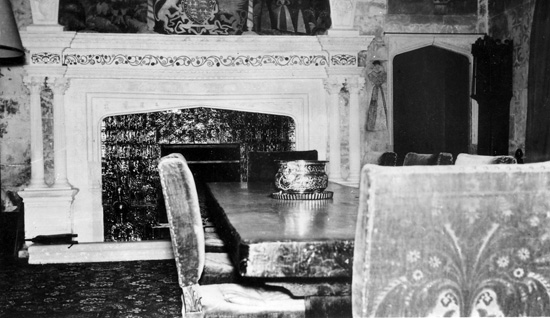Since it is difficult, from the evidence available, to fit the story of the Manor House into the main stream of the life in our village, I append here a few notes on its history.
About the year 1200 Geoffrey de Lucy held one fee in Berkhamsted, one in Slapton, half a fee in Byfleet, one in Hailes in Gloucestershire, and one in Newenton in Kent.
Somewhere around 1380 Geoffrey de Lucy held "a moeity of Gaddesden Parva of the Rector of Asherugge" (Chief Lord of Gaddesden). He held the manor of Wigginton, one-sixth part of Luton, and the manor of Coventone. He also held rights of free warren in Gaddesden, and in eight other manors, including "the Manor of Lucies in Newington in Kent."
Sir Reginald de Lucy in 1444 held 102 acres of land and 33s. 4d. rent in Gaddesden Parva by service of a fourth part of a Knight's fee, that is, by giving ten days' military service every year.
When William Lucy died, on 10th July 1459, the manor descended by the female line, until in Elizabethan times it was held by Sir Robert Dormer, who granted it on 2nd November 1601 to John and Robert Eames.
A stone panel carved in the front wall of the present house bears this inscription:
This seems to suggest that Sir Robert Dormer built the house. I wonder whether the two E's may have been added later by the Eames brothers.
It is difficult to say what this all adds up to. I should think it extremely improbable that the Lucies ever lived here. And it is quite likely that no house of considerable size stood here before the erection of the present house.
The house, lands, and rights passed into the hands of the Egertons in the seventeenth century.
Toward the end of the nineteenth century, a very old lady, Mrs. Bale, told the rector that long ago she had been a domestic servant at Lucies, and that the house was always called "The Priory." She said that a disastrous fire at the end of the eighteenth century had destroyed the greater part of the house.
In the early nineteenth century it appears to have been used as a Dame School, and then as a private dwelling and finally as the headquarters and armoury of the Company of Ashridge Volunteers.
 |
| Undated postcard captioned "Manor House, Little Gaddesden - The Fireplace." |
The lovely place is now chiefly noted for two things --- a contemporary portrait of Elizabeth, and the ghost of Jarman.
The former, which consists of a panel cut from a heavy oak door, shows us the neat and bright figure of the Princess, apparently at the moment of her arrest. She faces us, int he foreground of the picture, somewhat with the air of a startled hare. Behind her, three armed men approach with menacing intent. And a lady-in-waiting fades out of the left foreground. Over all hand the blossom-laden branches of a fruit tree. And if the cynical observer should object that this is a strange record of that dark happening upon a night of February, the discrepancy must be put down to the license allowed to artists.
William Jarman was churchwarden of the parish in the latter half of the seventeenth century, and his son William after him. The first William's grand-daughter was christened in 1702.
Tradition says that one of the two Jarmans was in love with the heiress of Ashridge, and that being disappointed in his suit, he killed himself in the house. I have heard no first-hand story of the appearance of the ghost.
The best authenticated tale is this:
About eighty years ago old Mrs. Cawtely was sitting in the drawing-room talking to her gust, when one after another, all the candles were extinguished. /The guest exclaimed, and the old lady said: "Don't take any notice, my dear, that is Jarman. He does this every year on this night." The story comes to me from one who heard it from the lips of the guest.
A village tradition says that once, long ago, Jarman became mischievous and that seven parsons, each bearing a candle, were called in to exorcise him. The candles were lit, and proceedings began. Jarman became more and more boisterous, and finally began to puff out the candle flames. At length one remained alight, but the parsons stuck manfully to their prayers. The last flame remained inviolate, and since then the poor ghost has remained the gentlest of lost souls.
Still, however, it would seem that there are moments when he desires darkness. The present residents were once plunged into sudden gloom. The fuse-box was intact, the bulb was in good order, and it was finally found that the switch on the standard lamp had been turned off.
The stone slab between the two great chimneys of the house is known locally as "Jarman's Coffin." And he looms largely enough in our minds for one parishioner to have spent a chilly hour waiting on the Green for Jarman's nightly visit to water his horse at Blue Pot Pond.
There are now no Jarmans corporeally resident in the parish, but the name still persists and is honourably borne in the surrounding districts.
There is an interesting illustrated description of the house in the Victoria History.
There is further information on the Images of England website. Please also see the Genealogy in Herfordshire website.
View Larger Map

